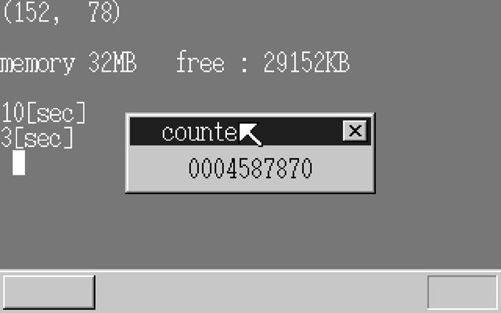4 重新调整FIFO缓冲区(2)(harib10g)
我们已经可以确定性能真正得到了改善,所以下面把程序恢复到harib10c,沿着13.2节继续思考吧。
既然可以把3个定时器归纳到1个FIFO缓冲区里,那是不是可以把键盘和鼠标都归纳起来,只用1个FIFO缓冲区来管理呢?如果能够这样管理的话,程序就可以写成:
if (fifo8_status(&keyfifo) + fifo8_status(&mousefifo) + fifo8_status(&timerfifo) == 0) {
冗长的if语句,也可以缩短了。那么或许harib10c中206行的bootpack.c也能简化。
■■■■■
在13.2节中,通过往FIFO内写入不同的数据,我们可以把3个定时器归入1个FIFO缓冲区里。同理,分别将从键盘和鼠标输入的数据也设定为其他值就可以了。那好,我们就这么办。
(写入FIFO的数值 中断类型)
0~ 1…………………光标闪烁用定时器
3…………………3秒定时器
10…………………10秒定时器
256~ 511…………………键盘输入(从键盘控制器读入的值再加上256)
512~ 767……鼠标输入(从键盘控制器读入的值再加上512)
这样,1个FIFO缓冲区就可以正常进行处理了。真是太好了!不过现在有一个问题,fifo8_put函数中的参数是char型,所以不能指定767那样的数值。哎,我们好不容易整理到1个缓存器中了,却又出现这种问题。
■■■■■
所以,我们想将写入FIFO缓冲区中的内容改成能够用int指定的形式。大家可不要担心哦。内容上与FIFO8完全相同。只是将char型变成了int型。
本次的bootpack.h节选
struct FIFO32 {int *buf;int p, q, size, free, flags;};
本次的fifo.c节选
void fifo32_init(struct FIFO32 *fifo, int size, int *buf)/* FIFO缓冲区的初始化*/{fifo->size = size;fifo->buf = buf;fifo->free = size; /*空*/fifo->flags = 0;fifo->p = 0; /*写入位置*/fifo->q = 0; /*读取位置*/return;}int fifo32_put(struct FIFO32 *fifo, int data)/*给FIFO发送数据并储存在FIFO中*/{if (fifo->free == 0) {/*没有空余空间,溢出*/fifo->flags |= FLAGS_OVERRUN;return -1;}fifo->buf[fifo->p] = data;fifo->p++;if (fifo->p == fifo->size) {fifo->p = 0;}fifo->free--;return 0;}int fifo32_get(struct FIFO32 *fifo)/*从FIFO取得一个数据*/{int data;if (fifo->free == fifo->size) {/*当缓冲区为空的情况下返回-1*/return -1;}data = fifo->buf[fifo->q];fifo->q++;if (fifo->q == fifo->size) {fifo->q = 0;}fifo->free++;return data;}int fifo32_status(struct FIFO32 *fifo)/*报告已经存储了多少数据*/{return fifo->size - fifo->free;}
■■■■■
下面我们就要写键盘和鼠标的相关程序了。我们不使用FIFO8,而是改为使用FIFO32。
本次的keyboard.c节选
struct FIFO32 *keyfifo;int keydata0;void init_keyboard(struct FIFO32 *fifo, int data0){/* 将FIFO缓冲区的信息保存到全局变量里 */keyfifo = fifo;keydata0 = data0;/* 键盘控制器的初始化 */wait_KBC_sendready();io_out8(PORT_KEYCMD, KEYCMD_WRITE_MODE);wait_KBC_sendready();io_out8(PORT_KEYDAT, KBC_MODE);return;}void inthandler21(int *esp){int data;io_out8(PIC0_OCW2, 0x61); /* 把IRQ-01接收信号结束的信息通知给PIC */data = io_in8(PORT_KEYDAT);fifo32_put(keyfifo, data + keydata0);return;}
本次的mouse.c节选
struct FIFO32 *mousefifo;int mousedata0;void enable_mouse(struct FIFO32 *fifo, int data0, struct MOUSE_DEC *mdec){/* 将FIFO缓冲区的信息保存到全局变量里 */mousefifo = fifo;mousedata0 = data0;/* 鼠标有效 */wait_KBC_sendready();io_out8(PORT_KEYCMD, KEYCMD_SENDTO_MOUSE);wait_KBC_sendready();io_out8(PORT_KEYDAT, MOUSECMD_ENABLE);/* 顺利的话,ACK(0xfa)会被发送*/mdec->phase = 0; /* 等待鼠标的0xfa的阶段*/return;}void inthandler2c(int *esp)/* 基于PS/2鼠标的中断 */{int data;io_out8(PIC1_OCW2, 0x64); /* 把IRQ-12接收信号结束的信息通知给PIC1 */io_out8(PIC0_OCW2, 0x62); /* 把IRQ-02接收信号结束的信息通知给PIC0 */data = io_in8(PORT_KEYDAT);fifo32_put(mousefifo, data + mousedata0);return;}
■■■■■
修改定时器结构体,让它也能使用FIFO32。
本次的bootpack.h节选
struct TIMER {unsigned int timeout, flags;struct FIFO32 *fifo;int data;};
本次的timer.c节选
void timer_init(struct TIMER *timer, struct FIFO32 *fifo, int data){timer->fifo = fifo;timer->data = data;return;}void inthandler20(int *esp){int i, j;io_out8(PIC0_OCW2, 0x60); /* 把IRQ-00接收信号结束的信息通知给PIC */timerctl.count++;if (timerctl.next > timerctl.count) {return;}for (i = 0; i < timerctl.using; i++) {/* 因为timers的定时器都处于运行状态,所以不确认flags */if (timerctl.timers[i]->timeout > timerctl.count) {break;}/* 超时 */timerctl.timers[i]->flags = TIMER_FLAGS_ALLOC;fifo32_put(timerctl.timers[i]->fifo, timerctl.timers[i]->data); /* 这里! */}/* 正好是i个定时器超时了。移位其余的定时器。 */timerctl.using -= i;for (j = 0; j < timerctl.using; j++) {timerctl.timers[j] = timerctl.timers[i + j];}if (timerctl.using > 0) {timerctl.next = timerctl.timers[0]->timeout;} else {timerctl.next = 0xffffffff;}return;}
■■■■■
这样,我们的准备工作就完成了。最后我们来修改bootpack.c。
本次的HariMain节选
struct FIFO32 fifo;char s[40];int fifobuf[128];(中略)fifo32_init(&fifo, 128, fifobuf);init_keyboard(&fifo, 256);enable_mouse(&fifo, 512, &mdec);io_out8(PIC0_IMR, 0xf8); /* 设定PIT和PIC1以及键盘为许可(11111000) */io_out8(PIC1_IMR, 0xef); /* 设定鼠标为许可(11101111) */timer = timer_alloc();timer_init(timer, &fifo, 10);timer_settime(timer, 1000);timer2 = timer_alloc();timer_init(timer2, &fifo, 3);timer_settime(timer2, 300);timer3 = timer_alloc();timer_init(timer3, &fifo, 1);timer_settime(timer3, 50);(中略)for (;;) {count++;io_cli();if (fifo32_status(&fifo) == 0) {io_sti();} else {i = fifo32_get(&fifo);io_sti();if (256 <= i && i <= 511) { /* 键盘数据*/sprintf(s, "%02X", i - 256);putfonts8_asc_sht(sht_back, 0, 16, COL8_FFFFFF, COL8_008484, s, 2);} else if (512 <= i && i <= 767) { /* 鼠标数据*/if (mouse_decode(&mdec, i - 512) != 0) {/* 已经收集了3字节的数据,所以显示出来 */sprintf(s, "[lcr %4d %4d]", mdec.x, mdec.y);if ((mdec.btn & 0x01) != 0) {s[1] = 'L';}if ((mdec.btn & 0x02) != 0) {s[3] = 'R';}if ((mdec.btn & 0x04) != 0) {s[2] = 'C';}putfonts8_asc_sht(sht_back, 32, 16, COL8_FFFFFF, COL8_008484, s, 15);/* 鼠标指针的移动 */mx += mdec.x;my += mdec.y;if (mx < 0) {mx = 0;}if (my < 0) {my = 0;}if (mx > binfo->scrnx - 1) {mx = binfo->scrnx - 1;}if (my > binfo->scrny - 1) {my = binfo->scrny - 1;}sprintf(s, "(%3d, %3d)", mx, my);putfonts8_asc_sht(sht_back, 0, 0, COL8_FFFFFF, COL8_008484, s, 10);sheet_slide(sht_mouse, mx, my);}} else if (i == 10) { /* 10秒定时器 */putfonts8_asc_sht(sht_back, 0, 64, COL8_FFFFFF, COL8_008484, "10[sec]", 7);sprintf(s, "%010d", count);putfonts8_asc_sht(sht_win, 40, 28, COL8_000000, COL8_C6C6C6, s, 10);} else if (i == 3) { /* 3秒定时器 */putfonts8_asc_sht(sht_back, 0, 80, COL8_FFFFFF, COL8_008484, "3[sec]", 6);count = 0; /* 开始测试 */} else if (i == 1) { /* 光标用定时器*/timer_init(timer3, &fifo, 0); /* 下面是设定0 */boxfill8(buf_back, binfo->scrnx, COL8_FFFFFF, 8, 96, 15, 111);timer_settime(timer3, 50);sheet_refresh(sht_back, 8, 96, 16, 112);} else if (i == 0) { /* 光标用定时器 */timer_init(timer3, &fifo, 1); /* 下面是设定1 */boxfill8(buf_back, binfo->scrnx, COL8_008484, 8, 96, 15, 111);timer_settime(timer3, 50);sheet_refresh(sht_back, 8, 96, 16, 112);}}}
哦,经过修正,bootpack.c简化成了198行,足足减少了8行呀。
■■■■■
下面我们执行“make run”。能不能顺利地运行呢?运行正常,太好了!

数字也在增加呀?!
嗯,和harib10c相比,结果值好了很多,竟然达到了1.7倍。
在模拟器上进行比较
harib10c:0002638668
harib10g:0004587870
这个结果可靠吗?(或许这个差异是模拟器或Windows造成的)。我们还是在真机上运行“make install”看看吧。
在真机上进行比较
harib10c:0074643595
harib10g:0099969263
差距是1.3倍左右。虽然改善幅度没有模拟器上大,但的的确确是改善了。
我们来想想这是为什么吧。定时器处理并没有变快,所以应该还有其他原因。……此次我们改写最多的是HariMain。在HariMain里,执行“count++;”语句和查询FIFO缓冲区中是否有数据这两个操作,是多次交互进行的。这次修改以后,程序只需要看1个FIFO缓冲区就行了,而以前要看3个。也就是说,FIFO缓冲区的查询能够更快完成,从而使得“count++;”语句执行的次数更多。
程序精简了,速度还变快了,太好了。
